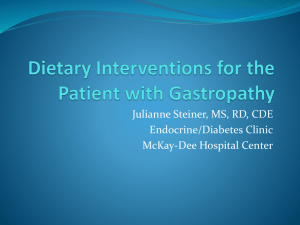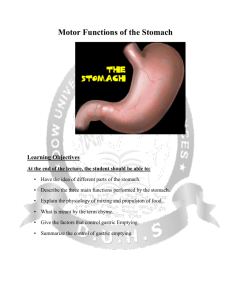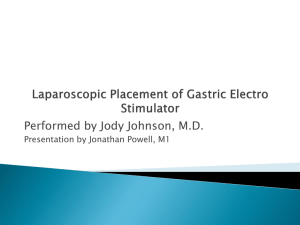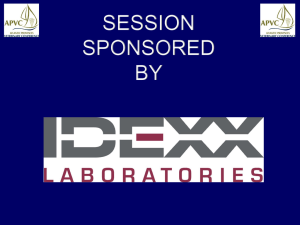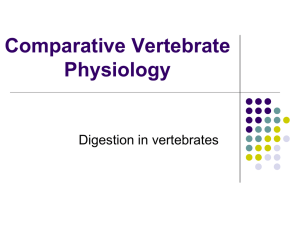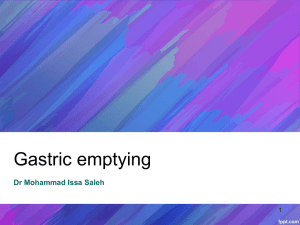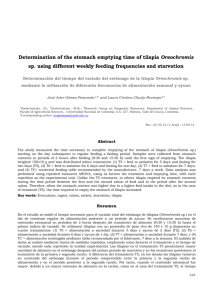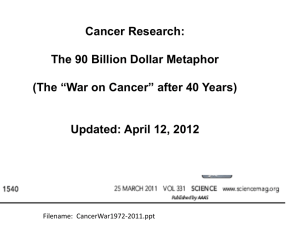Regulation of Gastric Emptying - mbbsclub.com
advertisement
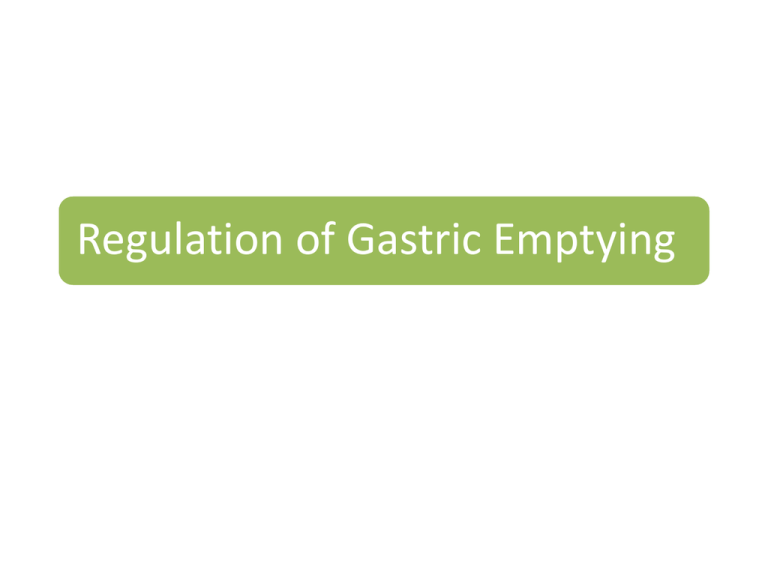
Regulation of Gastric Emptying Stomach Emptying • Stomach emptying is promoted by intense peristaltic contractions in the stomach antrum • At the same time, emptying is opposed by varying degrees of resistance to passage of chyme at the pylorus Intense Antral Peristaltic Contractions During Stomach Emptying—“ Pyloric Pump.” • Begins in midstomach & spreads through the caudad stomach no longer as weak mixing contractions but as strong peristaltic, very tight ring like constrictions that can cause stomach emptying • These intense peristaltic contractions create 50 to 70 centimeters of water pressure • The peristaltic waves, in addition to causing mixing in the stomach, also provide a pumping action called the “pyloric pump.” • • • • Role of the Pylorus in Controlling Stomach Emptying The thickness of the circular wall muscle becomes 50 to 100 percent greater It remains slightly tonically contracted almost all the time The constriction usually prevents passage of food particles until they have become mixed in the chyme to almost fluid consistency controlled by a very complex set of neural and hormonal signals Regulation of Gastric Emptying • Chyme must enter duodenum at proper rate Regulation of Gastric Emptying • Gastric emptying takes about 3 hours and very closely regulated so that nutrient absorption is maximized and H+ in the duodenum has time to be neutralized. • Fat and high H+ (acidic) content slow gastric emptying. Within the Stomach Gastric Factors That Promote Emptying • Effect of Gastric Food Volume on Rate of Emptying • Stretching of the stomach wall elicit local myenteric reflexes in the wall that greatly accentuate activity of the pyloric pump and at the same time inhibit the pylorus • Degree of fluidity of chyme Gastric Factors That Promote Emptying • Effect of the Hormone Gastrin on Stomach Emptying – Release of a hormone called gastrin from the antral mucosa – enhance the activity of the pyloric pump With in the Duodenum • When food enters the duodenum multiple nervous reflexes are initiated from the duodenal wall that pass back to the stomach to slow or even stop stomach emptying if the volume of chyme in the duodenum becomes too much. Regulation of Gastric Emptying • Activation of receptors in intestinal mucosa initiates enterogastric reflexes. This decreases gastric emptying by - • Inhibition of pyloric pump • Increased tone of pyloric sphincter Enterogastric Nervous Reflexes • Directly from the duodenum to the stomach through the enteric nervous system in the gut wall • Through extrinsic nerves that go to the prevertebral sympathetic ganglia and then back through inhibitory sympathetic nerve fibers to the stomach • Slightly through the vagus nerves all the way to the brain stem, where they inhibit the normal excitatory signals transmitted to the stomach through vagi Factors responsible for enterogastric inhibitory reflex • The degree of distention of the duodenum • The presence of any degree of irritation of the duodenal mucosa • The degree of acidity of the duodenal chyme • The degree of osmolality of the chyme • The presence of certain breakdown products in the chyme, especially breakdown products of proteins and perhaps to a lesser extent of fats • Role of Fats and the Hormone Cholecystokinin – Hormone released from the upper intestine – Stimulus for releasing these inhibitory hormones is mainly fats entering the duodenum – Bind with “receptors” on the epithelial cells – Carried by blood to the pylorus and increase the strength of contraction of the pyloric sphincter Outside the digestive tract • Emotions can influence gastric motility – Influence gastric emptying through autonomic nerves by influencing the gastric smooth muscle contractility • Intense pain can also inhibit the gastric motility by stimulation of sympathetic nerves Inhibitory Hormonal Factors • Cholecystokinin • Secretin • GIP


